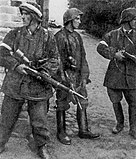Leśni
This article needs additional citations for verification. (November 2007) |
| Part of a series on the |
| Polish Underground State |
|---|
 |
Leśni (short for ["leśni ludzie"] Error: {{Lang}}: text has italic markup (help), Polish for "forest people") is an informal name applied to some anti-German partisan groups that operated in occupied Poland during World War II.
The "forest people" groups comprised mostly people who for various reasons could not operate from the communities they lived in and had to retreat into the forests.
Unlike most organized resistance groups, such as the Home Army, the "forest people" formed a sort of standing army, as opposed to regular partisan units that gathered shortly before an operation and afterward returned to their homes.
After the 1939 fall of Poland

The first such groups were formed in 1939, shortly after the invasion of Poland, mostly by marauders from the Polish Army and other people who evaded being arrested by the new Nazi or Soviet authorities. In March 1940 partisan unit of the first guerrilla commanders in the Second World War in Europe - Henryk Dobrzański "Hubal" completely destroyed a battalion of German infantry in a skirmish near the village of Huciska. A few days later in an ambush near the village of Szałasy it inflicted heavy casualties upon another German unit. To counter this threat the German authorities formed a special 1,000 men strong anti-partisan unit of combined SS-Wehrmacht forces, including a Panzer group. Although the unit of maj. Dobrzański never exceeded 300 men, the Germans fielded at least 8,000 men in the area to secure it.[1][2] (the most famous was the group of Henryk Dobrzański).
Under German occupation 1939-1945
Although most of the groups accepted the overall command of ZWZ and then the Home Army, different realities made them remain largely independent.
In early 1943 strength of the leśni groups can be estimated at about 40 groups numbering in total 1,200-4,000 fighters, but the numbers grew significantly during Operation Tempest in 1944.[3]
Uprisings, operations and battles
- Czortków Uprising
- Zamość Uprising
- Operation Wieniec
- Operation Arsenal
- Warsaw Ghetto Rising
- Operation Belt
- Operation Heads
- Operation Bürkl
- Operation Most III
- Operation Kutschera
- Battle of Murowana Oszmianka
- Battle of Porytowe Wzgórze
- Battle of Osuchy
- Operation Tempest
- Operation Ostra Brama
- Lwów Uprising
- Warsaw Uprising
- Attack on the NKVD Camp in Rembertów
- Battle of Kuryłówka
- Augustów chase 1945
Notes
- ^ *Marek Szymanski: Oddzial majora Hubala, Warszawa 1999, ISBN 83-912237-0-1
- ^ *Aleksandra Ziolkowska-Boehm: Polish Hero Roman Rodziewicz Fate of a Hubal Soldier in Auschwitz, Buchenwald and Postwar England, Lexington Books, 2013, ISBN 978-0-7391-8535-3
- ^ Roy Francis Leslie, The History of Poland Since 1863, Cambridge University Press, 1983, ISBN 0-521-27501-6, Google Print, p.234-235
